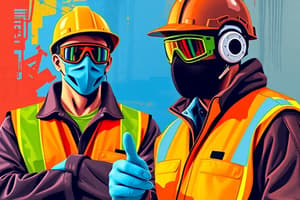Podcast
Questions and Answers
Personal protective equipment is the last resort when controlling the sources of accident is ineffective.
Personal protective equipment is the last resort when controlling the sources of accident is ineffective.
True (A)
What should be done with unfit or damaged personal protective equipment?
What should be done with unfit or damaged personal protective equipment?
Replace it immediately.
What is one of the basic requirements of safety helmets?
What is one of the basic requirements of safety helmets?
- It should be colorful.
- It can be easily removed.
- It must have a European Standard number. (correct)
- It should be made of plastic.
Match the following personal protective equipment with their purpose:
Match the following personal protective equipment with their purpose:
Prolonged exposure to high levels of noise can lead to hearing damage.
Prolonged exposure to high levels of noise can lead to hearing damage.
The essential conditions for burning are ____, ____, and ____.
The essential conditions for burning are ____, ____, and ____.
What is the most appropriate fire extinguisher for an electrical fire?
What is the most appropriate fire extinguisher for an electrical fire?
What should be done with used rags soaked with flammable liquid?
What should be done with used rags soaked with flammable liquid?
Workers should smoke within 'No Smoking Area' to prevent accidents.
Workers should smoke within 'No Smoking Area' to prevent accidents.
What is the risk of using cotton gloves when operating a machine with revolving parts?
What is the risk of using cotton gloves when operating a machine with revolving parts?
Flashcards are hidden until you start studying
Study Notes
Use of Personal Protective Equipment (PPE)
- Personal protective equipment is a last resort for accident prevention when controlling hazards fails.
- Employers must provide PPE and consider suitability, while employees should understand its selection, use, maintenance, and proper fit.
- Safety helmets protect against falling objects; mandatory at construction sites regardless of work duration, should bear safety markings like European Standard numbers.
- Safety helmet practices include:
- Maintain clearance between the head and helmet shell.
- Regularly check for damage and cleanliness without organic solvents.
- Don't remove the helmet harness or pierce holes for ventilation.
- Avoid placing a straw hat inside for sun protection.
- Safety shoes require steel toe caps, steel soles, and slip-proof features for effective protection.
- Full body harnesses significantly reduce waist injuries compared to general-purpose safety belts during falls.
- When handling chemicals, wear specific gloves, aprons, safety shoes, and face shields.
- Respirators must fit closely and should be cleaned post-use; use appropriate dust filters, masks, and eye protection in dusty environments.
- Prolonged noise exposure can cause hearing damage; approved ear muffs provide optimal protection.
- Wet drilling methods and dust removal are essential for tunnel drilling safety.
- Avoid cotton gloves near machines with revolving parts to prevent entanglement injuries.
- Stained uniforms with flammable liquids, sandals, and slippers are inappropriate work attire.
- Silicosis results from inhaling silica dust, particularly affecting hand-dug caisson workers.
Fire Safety
- Smoke inhalation is a primary cause of fatalities in fires.
- Fires require fuel, heat, and oxygen; prevention involves isolating fuel sources, cooling materials, and cutting off oxygen.
- Rubber floor tile installations using adhesives are high fire risk activities.
- Flammable liquids, such as during paint spraying, pose significant fire hazards.
- Burnable materials like paper, cloth, and timber are classified in the first fire category.
- Fire prevention strategies include:
- Regular checks of firefighting equipment.
- Keeping exit pathways unobstructed and workplaces tidy.
- Ensuring smoke doors remain closed.
- Careful use of spark-generating machinery.
- Establishing assembly points for post-evacuation.
- Storing flammable substances in metal cabinets and avoiding large quantities in workshops.
- Keep firefighting equipment accessible and unused rags soaked in flammable liquids in covered metal containers.
- Smoking should be prohibited in designated “No Smoking Areas” to avoid igniting nearby flammable substances.
- Water-type fire extinguishers are effective for timber fires but not for flammable liquid fires.
- Foam fire extinguishers are ineffective for electrical appliance fires.
- Disorientation may occur from dry powder discharge during fire extinguishing.
- Carbon dioxide extinguishers are best suited for electrical fires.
Studying That Suits You
Use AI to generate personalized quizzes and flashcards to suit your learning preferences.




